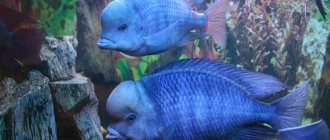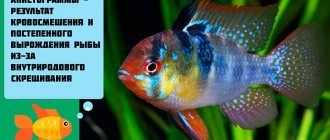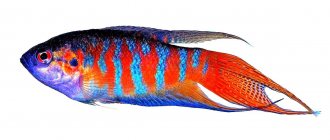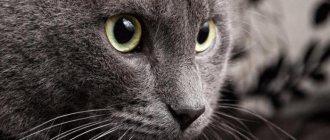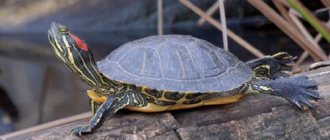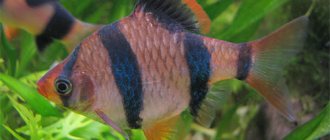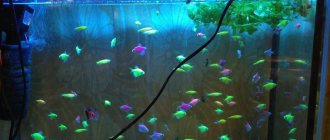Synonyms
Russian: Blue neon, Common neon, Neon tetra, Tetra neon Latin: Hyphessobrycon innesi, Cheirodon innesi
Etymology
Paracheirodon: From the Greek para meaning "associated with", and the generic name Cheirodon. innesi: named after the American aquarist, author, photographer, printer and publisher William T. Innes (1874-1969).
Family: Characinaceae Genus: Neons
History of discovery
These small fish owe their appearance in Europe to Auguste Rabaud, who was interested in exotic species of insects (primarily butterflies) and plants (orchids) for the collections of wealthy hobbyists and museums in different countries. He first saw this fish among the Indians when he was sick with fever. Neon floated in a clay vessel standing in the home. Rabo appreciated the find and, upon recovery, began work on transporting the fish to Europe. For a long time he hid the habitat of these luminous fish in order to maintain a monopoly on supplies. He sent several pieces to the famous tropical fish expert William Innes, who at that time was publishing Aquarium magazine in Philadelphia, in the hope that his magazine would create advertising for Rabo. Innes was surprised: it was the first time he had seen such wonderful fish. He immediately sent them for identification to one of the largest ichthyologists in the United States, Professor Myers, who described this species and gave it a specific name.
Other popular fish
Each breed is unique and may not conform to the general characteristics of the family to which it belongs. Each aquarist has to choose for himself which fish are suitable for him and the conditions that he can create for them.
The well-known piranhas are admired by predator lovers. And also Aristochromis cristi, a large carnivorous fish, colored in blue and gray tones, won the place. The following types of fish are distinguished: Sickle-tailed barracuda, Tiger perch, Golden leopard, Carapace, Exodon.
Among the non-standard aquarium dwellings, the most notable are the Toadfish and the Leaffish, named for their appearance, the fisherman catfish with a specific body shape, and the Bornean tetradon - the owner of red eyes. Fish with a transparent body, for example, Glass Angel and Glass Perch, look unique.
Tiger perch
Golden Leopard
Piranhas
Aristochromis cristi
Exodon
glass perch
There is also a group of Killi fish, united by their habitat. The list of fish includes about 1270 items. In nature, Killi live in small bodies of water, this is reflected in the appearance of the fish and gives them a similarity. The names of some of the species are: Azrak carp, Notobranchius Rachova, Panhax, Myers's fish, Florida and Japanese Orysia.
Calm and peaceful species of aquarium fish include the Spiny Catfish, Bolivian Butterfly, Geophagus Orangehead and Imperial Minnow.
Range and Habitat
South America: lives both in the tributaries of the Solimões River and in the forest tributaries of the Ucayali, Putumayo, Yarapa rivers (Peruvian part of the Amazon basin).
Even today, the true extent of its spread remains unclear.
These are rivers and small streams with peat bottoms, flowing under a very dense canopy of trees. Light penetrates the water through dense foliage in negligible quantities, creating twilight. Leaves and branches falling into the reservoir, rotting, acidify the water, and a thick layer of silt makes it difficult to wash out and dissolve salts from bottom rocks. Precipitation that falls during the rainy season also replenishes water bodies. Therefore, the water here is exceptionally soft, acidic, transparent and enriched with tannins and humic substances, which give it a brownish tint.
The vast majority of fish available in the aquarium trade are commercially produced and are more adaptable than wild specimens.
Feeding
The natural food of cyrtocara are bottom organisms and small fish. The blue dolphin is a representative of carnivores. A predator's diet should mainly contain protein products. These are any types of live and fresh-frozen food (brine shrimp, tubifex, bloodworms). We should not forget about the ability of living organisms to be carriers of parasites and harmful bacteria, so special attention should be paid to the choice of this type of food.
Freshly frozen food is safer for fish, but it cannot be considered balanced.
Some aquarists prefer to feed their fish raw minced meat from offal (liver, heart). But such a diet often results in problems with the digestive organs for pets and leads them to obesity.
Using high quality dry food is a good way out. Such food is considered safe and well-balanced, but fish should not be overfed.
Blue dolphin fish should be fed 2-3 times a day. Portions of food should be such that after a few minutes it is eaten without a trace.
Description
Apparently, in order to find each other in almost complete darkness, they have a bright stripe along the entire body, which, when exposed to the glare of the sun, flashes like a neon advertisement, either green or bright blue.
Under this stripe, starting from the middle of the body and to the beginning of the caudal fin, there is another, wider stripe of bright red color.
Size:
The female grows up to 35 mm, the male is usually 30 mm.
Behavior and Compatibility
The fish is peaceful, schooling, active, suitable for keeping in mixed aquariums.
It makes the greatest impression in large flocks of 20-30 or more individuals, together with species with similar conditions of detention and similar in size.
Buy as many as possible from 10 or more, since with this quantity the fish are more active and less shy, more often visible and have better coloring, and exhibit more natural behavior.
Motherland
The blue dolphin, or Cyrtocara, is prized for its unusual shape and coloring.
The natural habitat of the endemic species is in the shallow sandy areas of Lake Malawi, which is located in Africa. Representatives of this species can also be found in lakes Edward and Victoria.
There are several varieties of blue dolphins. First of all, fish with a bright blue or velvety blue color are valued. The presence of a large bump on the forehead is also important. If it was possible to breed individuals without a pronounced growth, then they will not be in demand.
Blue dolphins can have different color intensities depending on gender, species, and conditions of detention.
This fish was discovered and described by George Albert Boulanger in 1902. The species first appeared in Europe in 1968.
The fish quickly gained popularity due to its bright coloring and the absence of problems in breeding. In artificial reservoirs, the blue dolphin lives up to 10 years. The maximum size is 25 cm, but in an aquarium dolphins usually reach 15 cm.
Aquarium
Can be of any volume, preferably at least 40 cm in length and 30 cm in height.
The content is relatively simple. The aquarium must be equipped in accordance with the conditions of the natural reservoirs where they are found. The lighting is moderate, with shadows. The soil is dark (basalt chips, boiled peat) and driftwood, densely planted with plants (Thai fern, cryptocorynes, pinnate, Java moss, etc.), with free places for swimming.
They are unpretentious in terms of water composition, unless subsequent dilution is taken into account, and significant temperature fluctuations must be avoided. Prefers not too hard, slightly acidic water.
Water parameters:
Temperature: 21 - 28° C pH: 4.0 - 7.5 Hardness: up to 12° dGH
Keep in mind that they, like most fish in this area of South America, can withstand a slight increase in nitrites and nitrates, but do not tolerate a large amount of fresh water when changing it! It is better to replace in small portions, but more often.
Basic content rules
In terms of content, blue neon is unpretentious. Even a small aquarium (at least 10 liters) is suitable for him, which does not need to be covered with a lid or glass: neons are nimble, but not jumping. It is better to purchase a flock of 5-6 or more individuals.
Don’t forget to create a favorable living environment
Basic parameters for comfortable maintenance:
- water - +18-24 degrees. Excessive temperatures can halve the life of fish;
- dH - 5-7;
- pH - 6.5-7;
- lighting is moderate. There must be shaded areas;
- aeration and filtration are required;
- the soil is dark. Against its background, the fish look brighter;
- vegetation - any living plants that do not interfere with the fish’s free swimming;
- decorations - mounds of stones, decorative grottoes, caves, castles, snags.
Sexual Dimorphism
Sex differences in fish are weakly expressed. Mature females are usually noticeably rounder and slightly larger than males.
The female has a fuller abdomen and a bent green stripe, while males have a more slender body and a straight stripe.
In addition, in males the swim bladder, which is visible through the body, is shifted towards the anus, while in females it is closer to the spine. Blue neons become sexually mature at 5-8 months.
Breeding
Reproduction requires certain knowledge of hydrochemistry and experience in fish farming.
The main condition is careful preparation of producers, spawning grounds and, especially, water. Adult fish should not be used for breeding purposes. When preparing full-fledged breeders, you should take young individuals 2-3 months old, which are kept in certain conditions. The aquarium is filled with long-aged tap water with the addition of 1/4 part of distilled or pure rainwater. Males and females are kept separately and, regardless of the time of year, are fed live food, excluding the tubifex. It is enough to give daphnia and cyclops, as well as small bloodworms and coretra.
The water in the spawning area should be very soft (0.5-4°) and acidic (pH 5.5-6.5) with a temperature of 22-24° C.
For spawning they are planted either in pairs or in a flock of 5-10 pairs. To do this, it is necessary to select females with the same readiness for spawning. For one pair of producers, 5-6 liters of prepared water can be used.
It has been established that acidic water has bacteriostatic properties, that is, it inhibits the development of bacteria. This property is of great practical importance for fish breeding. It is known that in hard water (above 4-5°), the egg shell of many characins becomes impermeable to sperm, and fertilization does not occur. Therefore, it is necessary to artificially prepare water for spawning grounds. It is enough to take 10 liters of distilled water and add 1 liter of tap water. Place the container with soft water in a dark place and let it sit for two weeks. When acidifying water, you cannot use mineral salts, as well as sulfuric, nitric, phosphoric and other acids.
For breeding, all-glass aquariums are used, which must be thoroughly washed and disinfected. At the bottom it is enough to put a separator mesh or lattice and a bunch of Java moss. It is advisable to cover the spawning area with dark green paper on three sides; diffused light should enter it from the fourth. The water in the spawning area should be slightly aerated with small air bubbles.
Mature spawners are placed for spawning in the evening. The fish are not fed in the spawning area. Spawning usually begins the next morning. After laying the eggs (within 3-4 hours), the spawners are removed with a disinfected net, and trypaflavin is added to the water until it turns a soft yellow color. The spawning area is completely darkened. During spawning, the female throws out from 100 to 250 eggs. The males are placed in a reserve aquarium. This is done because females collect eggs after 7-10 days for the next spawning, while males are fully ready only after 15-20 days. Consequently, for the next spawning, other, unspawned males are added to the females. 20-24 hours after the end of spawning, larvae hatch from the eggs.
The larvae are equipped with yolk sacs, through which they feed, develop and turn into fry over 5-6 days. From this moment they begin to feed the fry. One half of the aquarium is slightly illuminated so that the fry, gathering in a darkened area, better take food in the illuminated part. They are fed with zooplankton sifted through a thick sieve and mixed with rotifers, which are the best starter food for neon fry.
We must remember that at first the aquarium with fry should not be brightly lit. The darkening is removed only at the moment when the fry are sufficiently strong, i.e. in 12-14 days. This period is the most crucial in raising fry, because... Due to their low motor activity in water, it is necessary to maintain a high density of food organisms. At 14-15 days, the fry can already eat small daphnia and cyclops. During this period, a red stripe appears on their body, and they become similar to their parents. The fry can be transferred to a large aquarium without soil, with water of the same composition and temperature as in the spawning tank. As the juveniles grow, water is added in small portions to the nursery aquarium in which they will be kept in the future (for gradual adaptation to the quality of the aquatic environment). The most negative factor for juveniles is a high level of protein substances and an excessive amount of bacteria in the water.
Life expectancy in an aquarium is about 3 years.
Notes
One of the most popular and recognizable fish in the aquarium hobby, this variety has been selectively bred into a number of additional forms, including albino, "golden", short-bodied, veil and "diamond" (which have shiny scales on the back).
Unfortunately, years of commercial breeding have somewhat affected the genetic strength of the ornamental strain, meaning that morphological defects and poor health are widespread.
The most common disease is plystophorosis. In sick fish, the color fades, the brightness of the neon strip disappears, and coordination of movements is impaired: they hold their tail down at an angle of 45-60°. Trying to get out of this position, they make jerky upward movements. They stop taking food. Treatment for the disease has not been developed. If it occurs, fish, plants, snails must be destroyed, the aquarium, nets must be disinfected, and the soil must be calcined or boiled.
identification:
Coloration is perhaps the most convenient method of identification for aquarists; differences in the color structure of P. innesi can be distinguished from its relatives Red Neon (P. axelrodi) and Green Neon (P. simulans).
P. innesi differs from P. axelrodi in that it has relatively less red pigment on the body, a narrower blue lateral stripe, and a more distinct white line on the anal fin.
It is distinguished from P. simulans by having a bluer (versus greener) lateral stripe that extends only to the adipose fin (versus the base of the caudal fin), more red pigment on the sides, and a more distinct white marking on the anal fin.
